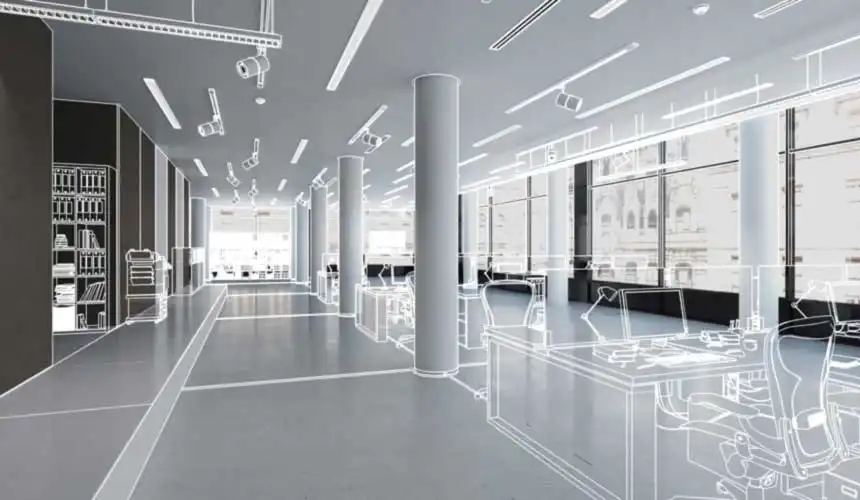
Architects, engineers, and construction professionals understand the benefits of building information modeling (BIM) in the early life cycle stages, when many teams need to coordinate vast amounts of data to design, plan, and build.
Later, in the operations and maintenance phases, facility managers can leverage modified BIM data to save time and cut costs. Because these phases are where you find most of the total cost of ownership, even small, simple efficiencies can bring significant savings.
But BIM can also deliver benefits for renovations and retrofits, both of which are set to become even more common. As companies work to entice employees back to the office by improving the employee experience, in many cases they’ll need to renovate their spaces.
Instead of the once standard rows of desks broken up by the occasional board room, floor planners want to incorporate spaces that better match new work habits, especially those that support connection and collaboration. And as building owners work to meet the increasingly challenging regulations for energy efficiency, they’ll need to retrofit.
In fact, some in the European Union (EU) have already set their sights on buildings — most of them dependent on fossil fuels for heat — because they account for roughly 40% of the EU’s energy use. “The proposed new rules could require millions of buildings to be upgraded using methods such as insulation or efficient heating systems,” according to a recent report by Reuters.
What is BIM and what are the differences between renovating and retrofitting?
Autodesk, the industry leader, defines BIM as “the holistic process of creating and managing information for a built asset.” The word holistic is key because BIM is all about pulling down data silos and facilitating communication across teams. “Enabled by a cloud platform, BIM integrates structured, multi-disciplinary data to produce a digital representation of an asset across its lifecycle, from planning and design to construction and operations.”
Renovations and retrofits are related to work done after a building is already in the operations and maintenance phases of the life cycle. Typically, renovations are for restoration, repair, or improvement. They can be as simple as painting the board room a new color or changing the space with new interior walls and lighting.
Retrofits are for improving the facility by adding new equipment, technology, or building systems. So, it could be as small as replacing the lights with low-energy alternatives, swapping out all the windows, or replacing the furnace with a modern, high-efficiency model. Building owners often do retrofits to meet new codes or insurance requirements. For example, replacing knob-and-tube wiring.
Other common retrofits are rooftops to reduce the need for maintenance and seismic to improve a structure’s ability to withstand earthquakes.
Regardless of the differences between renovations and retrofits, BIM technology can help both projects.
What are the benefits of BIM for renovations and retrofits?
BIM supports teams at every step of the project, from planning and execution to tracking results.
Solutions through simulations
From the start, BIM helps designers build accurate 3D models of different options so you can evaluate each one while seeing it inside the context of the existing structure. And because the models can include everything about the building, including the locations inside the walls of the plumbing, HVAC, and electrical wiring, you don’t have to worry about clashes.
If you’re renovating a breakroom and want to move the sink, you can see exactly what your limitations are based on the existing plumbing and locations of load-bearing walls. Once you know what’s possible, you can focus on what looks best and delivers the best use of the space.
If you have enough wiring in a wall to support a shared workspace with ten outlets where people can plug in their laptops, you can start thinking about where those outlets can go.
BIM allows you to simulate performance, helping you make the right decisions for retrofits. Which will better help you reduce heating and cooling costs, changing the HVAC system of the windows? It might depend on several factors, including the efficiency of the existing system and the location of the building. With BIM, you can create accurate simulations that help you test different solutions to find the best one for you.
More communication, less cost
BIM supports sharing and helps eliminate miscommunication. Because every team works from the same data, they’re all on the same page for materials, plans, delivery dates, and outcomes. No one arrives on site early or late, and everyone has what they need to work effectively.
Overall project costs are controlled by reducing waste. Vendors and trades are only there when they can work, so you’re not spending money on people standing around. Better tracking of materials and supplies means less loss to shrinkage. And because the work is better planned, it’s better executed, reducing or eliminating the need for costly rework.
What is a BIM for renovations and retrofits case study?
In “BIM for historical buildings in the UK focused using sustainability tools,” a presentation at Autodesk University 2023, Gareth Sewell, Head of BIM at Purcell, positions the importance of renovations and retrofitting in a wider environmental context. Starting in 2020, there is more anthropogenic mass than all global living biomass. So, he argues we need to change the definition of the word “historical.”
Now, instead of meaning a building people feel connected to, because of the pressures of sustainability and climate change, we need to think of every completed building as historic and focus on retaining, reusing, and repurposing them. We need to move toward a circular economy.
“The most carbon-neutral asset is the one already built,” Sewell says.
BIM can help with the common challenges of working with clients who want to retrofit their buildings to reduce their carbon footprints. First, it can be hard to capture data on the structure as it stands now. Especially when looking at much older buildings, it can be hard to get data on what materials were used and the construction process.
BIM can help because it allows you to create an open repository of data that people worldwide can contribute to and leverage. Sewell sees this as a way to ensure retrofitting projects can also happen in developing countries.
The next challenge is finding ways to efficiently present the data to clients in ways that they can easily understand. By building models and dashboards with real-time data, you can show not only the current structure but also offer opportunities to try different designs, each with specific data on the expected outcomes for energy use.
Without BIM, developing new iterations and options is a slow, resource-intensive process. But with it, clients can quickly see how different designs would affect their use of the building and its energy use.
“We are offering a re-imagining service, which will be better for the environment generally,” Sewell explains.




